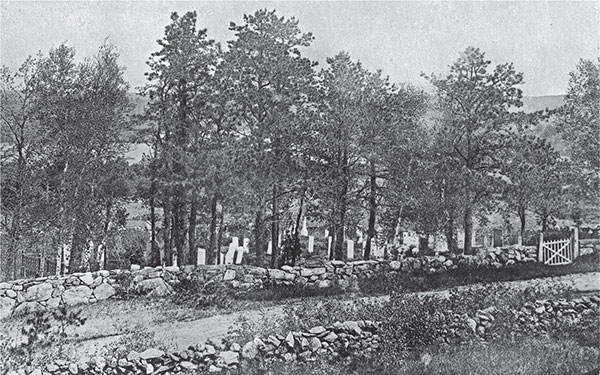
An 1883 photograph of the Cemetery on the Hill, where many of the early settlers were buried. From History of Windham in New Hampshire (Rockingham County), 1719–1883.
16
COBBETT’S POND
The history of Cobbett’s Pond begins with the man whose name the pond eventually came to bear, Reverend Thomas Cobbet. Cobbet received the pond in a land grant in 1663. However, he never actually lived on the land, and neither did any other Europeans until 1719. Much of Cobbett’s Pond’s early history involves the Native Americans of the Penacook tribe who lived in the area. The pond was a favorite fishing spot of the Native Americans, and they would also grow their crops in the vicinity of the pond. When it was time to grind the grain, they could make a trip by canoeing across, or walking around, the pond to a large boulder near the north side. Small indentations on the boulder are evidence of its use as a mortar for grinding grains with a handfashioned stone pestle. Aside from the boulder, many arrowheads have been found around the pond, suggesting it was a popular spot for the Native Americans.
One of the earliest references made to the pond referred to the body of water as Draw Pond. Why this name was chosen has been lost to history. The name Cobbett’s, or some variation of it, was used to describe the pond as early as the first half of the eighteenth century. Before the name Cobbett’s was used almost exclusively for the pond in the late nineteenth century, many variations were used. These include Cabot’s, Corbett’s and Cobbet’s; the pond was also referred to as Cabbage Pond at one time, but it is up to the reader to decide how one might have derived that name from any of the other spellings.

An 1883 photograph of the Cemetery on the Hill, where many of the early settlers were buried. From History of Windham in New Hampshire (Rockingham County), 1719–1883.
The first settlement in Windham was located near the shores of Cobbett’s Pond; a home was built on Copp’s Hill by John Waddell around 1720. Windham’s early settlers were likely attracted to the pond by its untouched, picturesque setting. Not only did some of the settlers build their homes overlooking the pond, but one of the town’s first cemeteries was also laid out on the east shore of the pond, giving the deceased a permanent place overlooking the body of water.
In 1728, a group of fourteen Londonderry farmers received grants for land on the south and east sides of Cobbett’s Pond in order to settle a dispute over the tracts of land they had originally received. The landholders argued that when their land, in what is now Derry, was laid out, each was not given a fair share. Eventually, the proprietors settled by offering the men a total of 594 acres of land, which reached from Cobbett’s Pond to Canobie Lake. These farms were some of the most prosperous in town for over a century.
When the town hall and Presbyterian Church were built at the town center, some of those who lived along the shore of Cobbett’s Pond routinely traveled there via rowboat. Whether it be attending church service on Sunday or for other business, a trip by boat would have certainly been quicker and more efficient than making the trip on foot or by horse. However, one such trip proved to be fatal on one particular occasion. On November 2, 1834, Reverend Jacob Abbott and John Dinsmoor, along with each of their two sons, decided to cross the pond by boat in order to attend church. Out of precaution, they decided two trips should be made for the group so as to not overload the boat.
However, when they were returning from church service, the decision was made that such a precaution was not necessary; all six should return home in the same boat. The added weight only worsened the condition of the boat that was already prone to leak. It began to take on water at a much greater rate than it did that morning, and the boat capsized before the group could make it to shore. Fortunately for the young men, they were able swimmers and swam to shore, although one did have some difficulty. Ebenezer Abbott went down with the boat three times before he was able to save himself. On the third time down, his finger became caught in the boat’s chain, which made it possible for him to grab the chain and pull himself up. It is recorded that he kept that chain for the rest of his life. Their fathers were not so fortunate; Reverend Abbott and Dinsmoor both drowned.
Farmers whose pastureland was located along the shores of the pond saw the location as advantageous due to the easy access their animals had to fresh water. Not only was the crisp, clean pond a source of water for farm animals, but it also had plenty of uses for those living near the pond. If water was needed for cooking purposes or any other household chore, it would have been convenient to take a short stroll down to Cobbett’s Pond and fill a bucket or two with water. When winter came along, the pond proved to be a valuable source of ice, which was used for storing perishable foodstuffs. The pond was also a prime fishing spot, undoubtedly providing many families with food. These were among the many reasons why Cobbett’s Pond became so valuable to the early inhabitants of Windham. However, by the turn of the nineteenth century, the reasons behind the allure of the pond began to shift.
As cities grew around the mills of Massachusetts, more and more people wished to escape the hot, crowded cities during the summer months. The appeal of a cool, clean lake or pond would have been almost irresistible. Summer vacationers had already been visiting nearby Canobie Lake for decades, so it was only natural that Cobbett’s Pond would also become a summer destination. In 1883, the Horne family of Lowell, Massachusetts, became the first people to purchase land on Cobbett’s Pond for the purpose of spending summers there. For the first several years, the family stayed in a tent near the shore, but eventually a cottage was built.
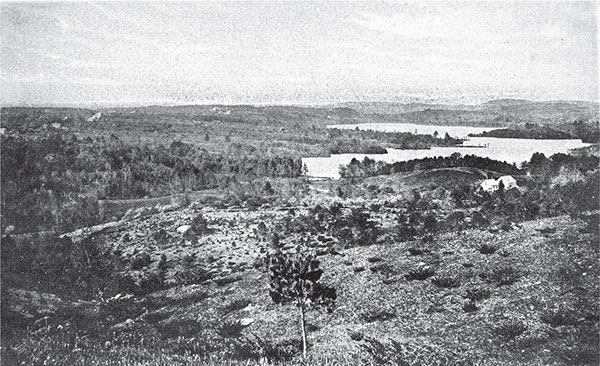
This view of Cobbett’s Pond from the north shore shows how the shoreline looked in 1883, before any summer cottages were constructed. From History of Windham in New Hampshire (Rockingham County), 1719–1883.
The first cottage on the pond was built by Frank Ayer in 1886. It was built on land owned by G.W. Noyes. Ayers led a group of men from Nashua, who desired to use the cottage as a summer getaway. By the late 1890s, the Ayer cottage was no longer alone on the pond, as many cottages were constructed along the shores of the pond. In 1894, Albert Simpson constructed a public resort named Sycamore Grove at the south end of the pond. Although not an amusement attraction like its competitor, Granite State Grove, the operation did attract many picnickers. The business and land were sold to Julia Baker shortly after the turn of the twentieth century; incidentally, she was one of the first Windham residents to own a motor car.
In 1895, William Harris saw a different type of seasonal potential in the pond, and he began constructing cottages on the north shore. This summer colony became one of the fastest-growing cottage colonies on the pond at the time. However, summer vacationers seeking to reach their summer cottage or just spend a day at the pond were met with inadequate transportation. As cars were still not commonplace, many were forced to take a train, usually to Canobie Lake Station. From here, some would either walk or be met by friends who would take them by wagon or carriage to the pond. One enterprising Salem man by the name of E.J. Nickerson opened a business offering to pick up vacationers at the station and bring them to Cobbett’s Pond.
Those with an entrepreneurial sense, such as Charles Alexander and Charles Dow, saw the demand for cottages as the foundation for a successful real estate development enterprise. In 1903, Dow and Alexander bought one mile of waterfront land, which was then subdivided into sixty-six fiftyfoot lots. The development necessitated building a horseshoe-shaped road leading from Range Road, which ran parallel to the pond, to each of the lots. One of the original stipulations in the land deeds was that each new owner would maintain his own section of the road. After the first year of marketing the lots, only six had been sold and just one cottage had been built. Some lots took nearly two decades to sell. In 1918, Alexander sold a lot to Karl Norris, who then resold it in 1924 to the author’s paternal great-grandfather Erich Obst. Although the lot may have been small, the price could not have been beat—Obst paid one dollar. A boathouse and cottage were eventually erected on the site, and the Obst family spent many wonderful summers at Cobbett’s Pond for several decades.
The popularity of the pond began to increase, and the lots eventually began to sell as more and more cottages were built. By 1912, there were seventy cottages on Cobbett’s Pond. Many of these cottages had a rowboat or canoe, as no summer on the pond could be complete without a day spent fishing or simply enjoying being out on the water. As early as the first decade of the twentieth century, there was at least one motorboat on the pond, an unusual sight for those who had never seen the then modern technology. In 1911, Henry Newhall brought his four-horsepower motorboat to his summer cottage on the pond. Many of his neighbors were understandably jealous.
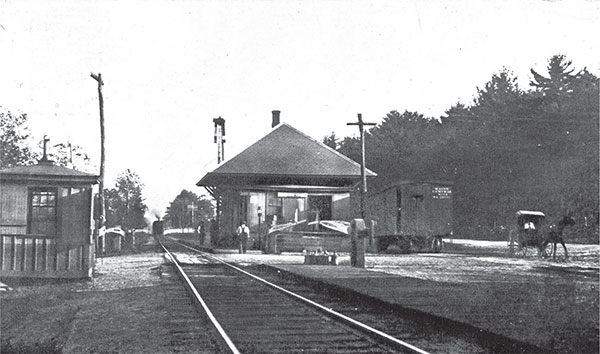
Canobie Lake Station, circa 1910. During the summer months, the trains stopping at the station would be filled with passengers on their way to Cobbett’s Pond. Author’s collection.
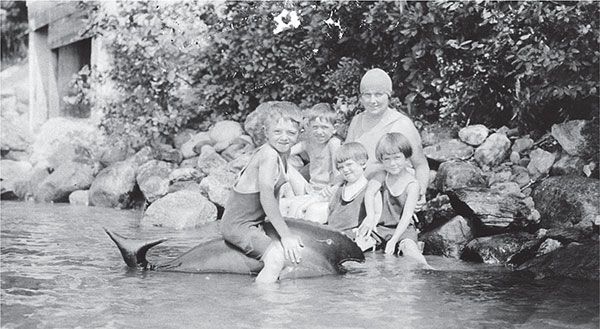
Helen Obst and her four children enjoying a summer day at Cobbett’s Pond in the early 1930s. Author’s collection .
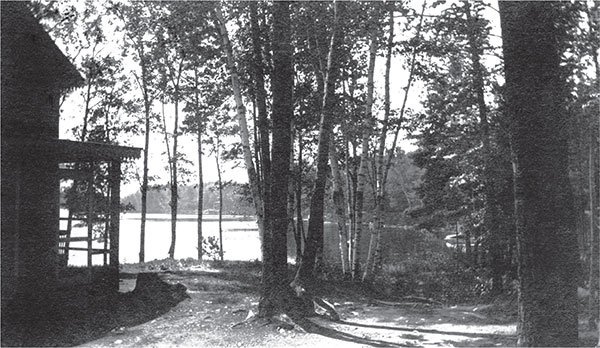
A circa 1910 view of Cobbett’s Pond from the back porch of Shady Shore Cottage. The cottage would have been one of many rented to summer vacationers. Author’s collection .
As decades passed and the popularity of Cobbett’s Pond only grew, other real estate speculators decided to take advantage of the high demand for lots. In 1929, a syndicate named Lake Shore Development Trust was formed to purchase sixty acres of land near the pond. Only looking to turn a profit, the land was subdivided into 975 lots, plus a community beach and a playground. The lots were around twenty by one hundred feet, which were not suitable for building an average-size summer cottage. However, those who were looking to build a small shack or tent would have found their needs perfectly met by these new lots. Each of the waterfront lots sold for fifty dollars, and the back lots sold for just twenty dollars. There was a catch though; each buyer had to pay the property owners an additional fifty dollars to record the deed.
This venture was not very successful due to a combination of two major drawbacks. First, there were no properly built roads to the lots. It was the responsibility of the purchasers to build the road. Second, many of the lots were much too far from the water. Although there was a community beach, many prospective buyers desired their own water frontage or, at least, a relatively clear view of the pond. When the owners were left paying taxes on properties that were seemingly unsalable, they came up with an unusual strategy to liquidate the remaining lots.
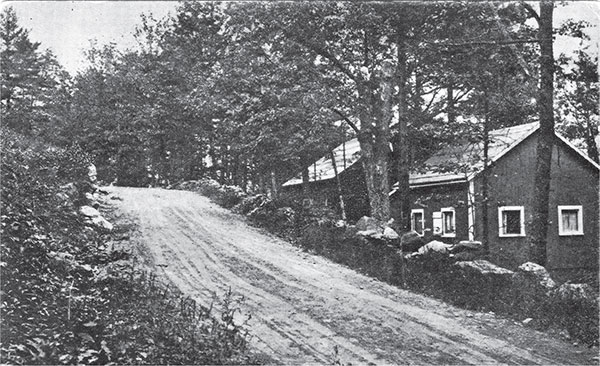
Butler’s camps along the shore of Cobbett’s Pond. The camps were one of several small rental cottage “colonies” on the pond. Author’s collection .
Rather than sell lots, they would give them away. Through a promotional deal with local grocery stores, one of the back lots would be given away with the purchase of either five pounds of tea or a single pound of coffee; to take ownership of the lot, there was still a fifty-dollar recording fee. This scheme was rather successful, and twenty cottages had been built on the lots by 1934. When the same property owners failed to sell some of their lots around a pond in Pelham, they used the same scheme, which was also rather successful. Giving away the lots may have also helped to sell other lots. When someone took ownership of a lot and wanted to build on it, they would’ve been forced to purchase at least a few surrounding lots in order to have a large enough parcel.
Not everyone who desired to spend a summer day at Cobbett’s Pond had the luxury of owning a cottage or even an unimproved lot. For locals and vacationers alike, there were several beaches around the pond that were open to the public. Beaches, including Hadley’s and Bella Vista, were prime spots for both swimming and picnicking. Those who were looking for a little excitement could pay a quarter for a boat ride on one of the boats of the Dunkley brothers. As late as the middle of the twentieth century, boats were still somewhat of a novelty, and a ride on a Gar Wood or a Christ Craft was certainly an event not easily forgotten.
The beaches also offered summer refreshments, such as hot dogs and ice cream. At Dunkan’s Beach, a pavilion was eventually constructed that grew to include a jukebox, pinball machines and a gift shop. Bud’s Corner operated as a snack stand near the south shore of the pond and sold a variety of summer refreshments, from ice cream to fried clams. Still, swimming was the biggest attraction at the beaches. As the number of swimmers grew, there became a need to ensure the safety of the public. Although many beaches had lifeguards, there was not a town ordinance requiring them until the early 1970s. The same ordinance also required that the lifeguard have access to a telephone as well as the appropriate emergency equipment. However, many of the beach owners were not so keen on the new regulations. They argued that on some days, many people came to picnic rather than swim, and hiring a lifeguard would have been an extraneous expense; there were also some days when the number of people swimming would not have warranted a lifeguard.
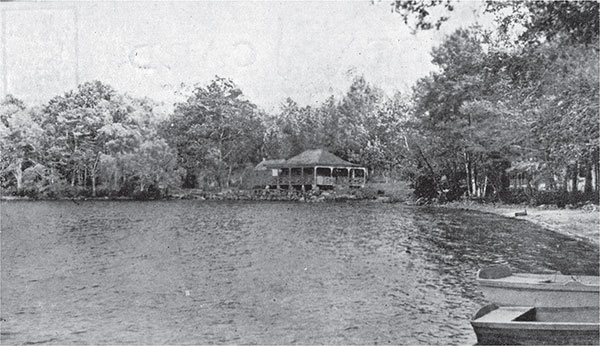
The pavilion on Cobbett’s Pond; one of the earliest recreational businesses to operate on the pond. Author’s collection .
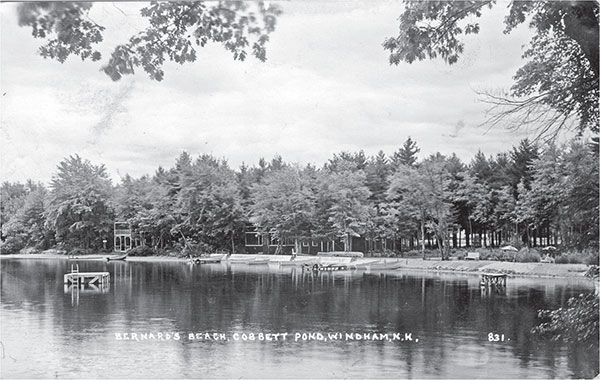
Bernard’s Beach on Cobbett’s Pond as it appeared in 1933. Author’s collection .
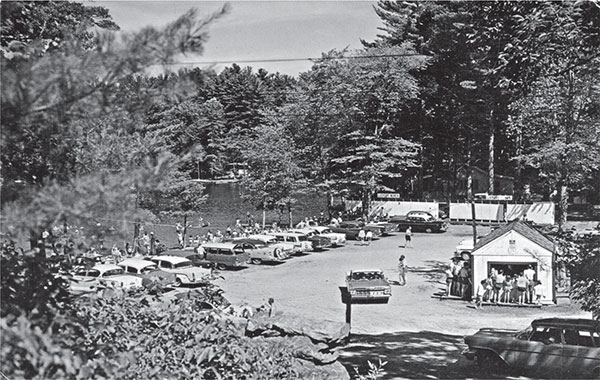
A mid-twentieth-century postcard view of Hadley’s Beach on the south shore of Cobbett’s Pond. The beach now serves as Windham’s town beach. Author’s collection.
The beaches did not last long. Within the next decade, many of the beaches closed, and access to Cobbett’s Pond by nonresidents was severely limited. It also became increasingly hard for summer vacationers to find a rental property along the pond, as many homes were privately owned. What was once a thriving tourist destination gave way to a relatively densely populated, for Windham, residential area. As of this writing, two of the original beaches still exist on the pond. One is Community Beach, which is still privately owned by surrounding property owners. The other is the former location of Hadley’s Beach, which now serves as a beach open to only town residents. Despite all the changes, it is still possible for Windham residents to spend a day fishing or swimming in Cobbett’s Pond, just as the vacationers of one hundred years ago did.